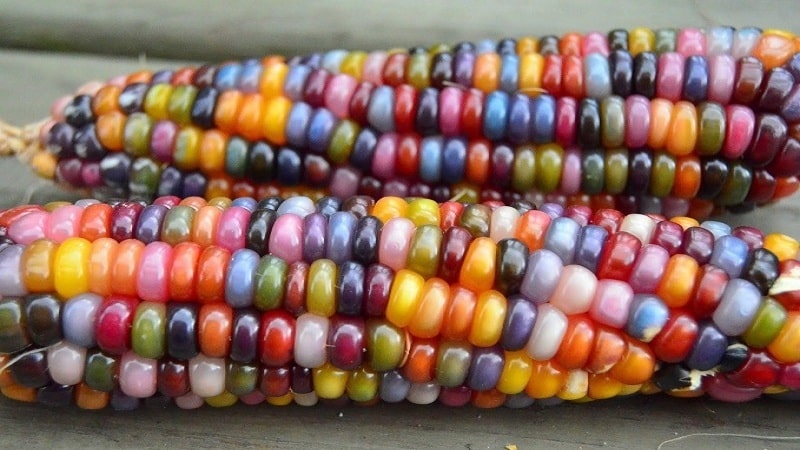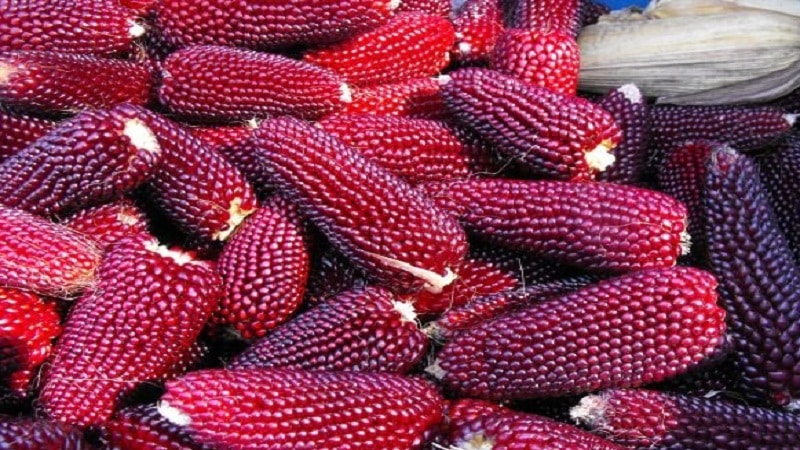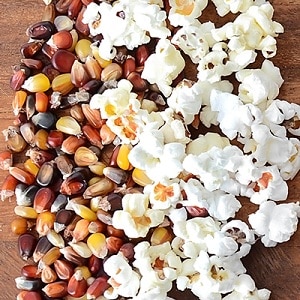Colored corn - reality or photoshop: let's get acquainted with amazing varieties and try to grow it yourself
American Carl Barnes was the first to grow colorful corn. He was inspired by the idea of reviving the culture that was highly valued by the ancient Indian tribes. After many years of hard work, a farmer from Oklahoma received corn with kernels of all kinds of colors.
Today, gardeners have the opportunity to grow crops in a variety of shades: from golden to blue-black. In this article we will tell you about the history of the creation of colored corn, the features of cultivation different varieties and ways of using it in everyday life and cooking.
Colored corn - fiction or reality
Those who have never seen corn with kernels painted in all the colors of the rainbow will most likely think that a Photoshop wizard worked on the images. In fact, such varieties have existed since time immemorial.
Corn is an ancient crop that was grown by the indigenous people of North America and used as animal feed. And the multi-colored varieties developed relatively recently are just well-forgotten old ones. Each cob is completely unique. If you take several pieces for comparison and carefully examine the drawing, you will notice that the color combinations are not repeated and the grain size is different.
The Spanish Franciscan Bernardino de Sahagún, in his memoirs of visiting Indian tribes, describes corn cobs of amazing beauty with black, blue, red, white and yellow kernels.The culture quickly spread throughout Europe, but gained the greatest popularity in Japan and China.
In the USSR, corn began to be cultivated during the reign of Khrushchev, who tried to quickly introduce it into agriculture. At that time, preference was given to sugar varieties with yellow and orange grains. The main task was to solve the problem of shortage of animal feed and at the same time increase profitability, and no one cared about the decorative function.
The most famous varieties
The most popular varieties around the world are Glass Gem and Multicolor Aztec Corn. Let's look at the features of each of them in more detail.
Glass Gem
The American variety of corn, Glass Gem, is characterized by its bright color with unimaginable combinations of shades. It appeared thanks to the efforts of breeder Carl Barnes, who has Cherokee Indian roots, and his student Greg Shawn. They came up with a name for the variety - Glass Gem, which translated from English literally sounds like Glass Gamma. The second name is more romantic - Glass Pearl, and it is actually true. Corn kernels resemble pearlescent little pearls, but boast a wider range of colors.
The process of creating a new variety was painstaking, and it took a long time to achieve the desired result. Barnes used corn of different colors and crossed them using open pollination.
Glass Gem is a siliceous variety, which means that the grains have a very dense structure, so they are not used for food boiled. This variety is suitable for making rainbow popcorn and cornmeal.
Pictured are Glass Gem corn cobs.

Multicolor Aztec Corn
This variety of corn was born thanks to the Aztecs, who once lived in the mountains of what is now the American state of Montana. Multicolor Aztec Corn is one of the most genetically diverse varieties widely cultivated today. The cobs contain grains of various shades: orange, yellow, golden, purple, blue, red.
Unlike Glass Gem, this variety can be use boiled, but only if the cobs are very young. When boiled, the colors do not fade and remain just as bright. More mature specimens are used for making flour, cereals, frying, baking and canning.
Reference. Flour is used to bake aromatic bread high in antioxidants.
The photo shows the Multicolor Aztec Corn variety.

Characteristics and description of varieties
The following varieties of multi-colored corn are grown in the vastness of our country:
- Early pink glow. An extra early variety of corn. The harvest can be harvested three months after sowing. It grows no more than 1.2 m in length, the cobs are pyramid-shaped, about 15 cm long, the grains are colored lilac-pink, and have a pleasant sweet taste. Corn is suitable for consumption in boiled form.
- South America. Reaches a height of 2.5 m, the length of the cobs is 22 cm. The grains have a variegated color. The cobs are used for decoration, making popcorn and flour.
- North America. The grains have a lilac-chocolate hue. The stem grows up to 1.8 m in length.
- Nacre. Mid-season variety, grows up to 2.2 m in length. The ears are 14 cm long and have a slightly rounded pyramidal shape. The shade of the grains is white-lilac with a pearlescent tint. The cobs are eaten boiled at the stage of milk maturity.
- Magic kaleidoscope. Grows up to 1.8 m.The cobs contain grains of white, yellow, brown, orange and black colors. Propagated using seedlings, which are planted in open ground in early May. Loves sun and good drainage.
- Strawberry. An ornamental variety, it has ears of an interesting shape with sharp red grains. The crop loves warmth and grows best in regions suitable for growing sweet corn. The harvest is harvested in late August - early September. The cobs are shaped like berries or cones. Milk ripe grains have a sweet, pleasant taste and can be eaten. During the period of intensive growth, the crop needs to be fertilized with nitrogen, phosphorus and potassium. Suitable for creating hedges.
- Amero. The variety is grown in open ground in regions with a sufficient number of sunny days. Suitable for consumption at the stage of milk maturity. The variety tolerates drought well, but with a lack of life-giving moisture, it loses its decorative properties. The grains are colored in yellow, dark orange, brown and golden shades.
- Mosaic. The variety has decorative ears with grains of black, white, gold and brown colors. They are grown in the fertile soils of the southern regions. Corn is used to create decoration.
Outside Russia, the Purple Maize variety is widely known. This corn has grains the color of ripe blackberries due to the presence of special pigments - anthocyanins. It has medicinal properties and is cultivated over large areas in Peru.
Hopi corn is grown in Mexico and the southern United States. Its kernels are dark blue in color, have a low glycemic index compared to yellow corn, and have antioxidant and anti-inflammatory properties.

Is it possible to eat colorful corn?
Colored flint corn contains a large amount of hard starchy compounds. Therefore, the grains are very dense to the touch and are suitable for making popcorn, cereals and flour.
Varieties of colored corn with grains of milky ripeness (not fully ripened) can be eaten boiled. These grains are quite soft and sweet in taste.
How to grow your own
The technology for growing colorful corn is not much different from the usual sugar varieties. The culture loves the sun, fertile soil, and tolerates drought well. For planting, choose windless areas with good lighting. At the initial stage, follow the rules of moderate watering. Apply fertilizers in a timely manner: at the beginning of flowering and at the stage of cob formation.
Sowing begins in late April - early May, when the soil warms up well. Planting depth is no more than 5 cm. Before sowing, the seeds are heated in the sun for several days, then dipped in a jar of warm water for 24 hours. The sowing pitch is 40 cm.
Applications of colored corn
Corn with multi-colored grains is used less often in cooking than in applied arts. The fact is that not all varieties are suitable for food, given the special hardness of the grains. Some of them can be consumed at the stage of milk maturity, and after full ripening - as decoration.
In cooking

Multi-colored varieties of corn are used to make popcorn, candy sticks, cereals, cereals and flour. Some of them can be consumed boiled at the stage of milk maturity. These grains have a pleasant sweet taste and are endowed with many beneficial properties. They are used to prepare soups, salads, cereals, bake bread, tortillas, and bake on the grill.
For decoration
Colored grains make unique decor for the kitchen. They are poured into transparent glass jars in layers or randomly, creating rainbow panels. Some craftswomen manage to make bracelets and beads from multi-colored mother-of-pearl grains. In the USA, colored cobs are tied and used to decorate the entrance to the house on Thanksgiving Day.
It is useful to give small grains to children for developing fine motor skills and making crafts, but, of course, only under the supervision of their parents.
Where to buy seeds
It is not difficult to purchase seeds of colorful corn. They are presented in an assortment in specialized stores or on online platforms. For example, on AliExpress or eBay such seeds are sold at an affordable price. Judging by reviews from gardeners, the germination rate of the Chinese product is more than 50%. The average price is from 35 rubles per bag of 20 seeds.
Conclusion
Corn is a unique crop with a centuries-old history of cultivation and cultivation. We are used to seeing cobs of the traditional yellow color on the tables and know practically nothing about multi-colored specimens. It turns out that growing them does not create any particular difficulties. The main thing is to choose a well-lit place and apply fertilizer on time. Choose varieties for sowing that are suitable for human consumption. This approach is more rational in terms of saving money and labor costs.